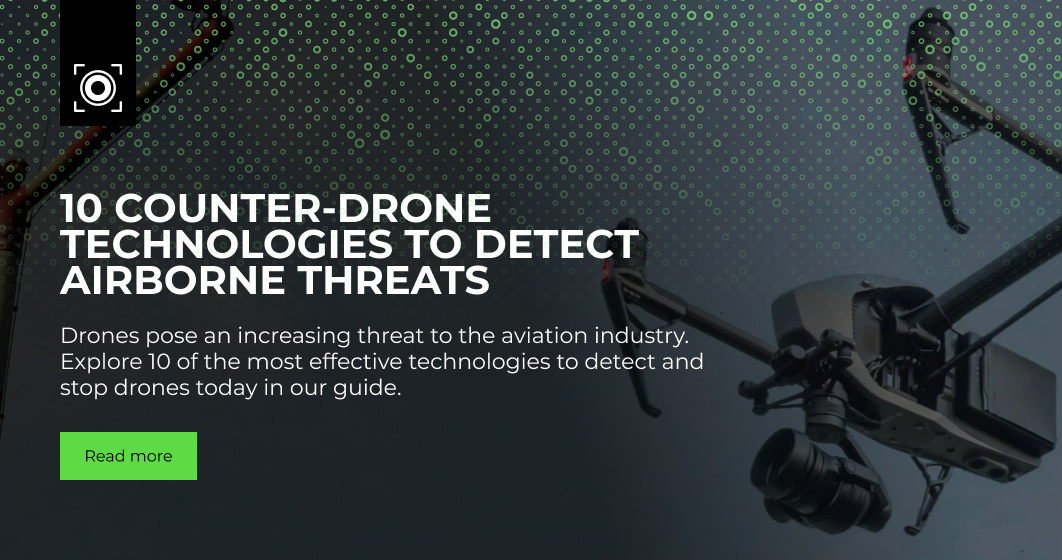The Pentagon made global headlines in 2017 when it gave US military bases permission to shoot down any commercial drone that enters their airspace. And it's easy to understand why.
A high-speed collision between a small drone and a manned aircraft can cause significant damage. It costs the US military $78 million to build a single F-35A fighter jet, so it stands to reason they'd want to protect their assets at all costs.
It's hard enough to detect a drone – let alone neutralise it. No one solution is up to the challenge, which is why operators create multi-layered drone detection solutions to mitigate airborne threats.
Each technology deserves an article explaining where it fits into the wider picture. In this one, we focus on radio frequency (RF) jammers.
What are RF Jammers for Drones?
Radio frequency jammers are one of several non-kinetic drone countermeasures operators use to neutralise airborne threats. Some are portable handheld or shoulder-mounted devices. Others are large, static systems that form a network around the perimeter of restricted airspace.
They work by transmitting electromagnetic signals at the same frequency as the signal that passes between the drone and its controller. This overrides the drone’s communication systems, which causes it to do one of four things:
- Activate its Return to Home function
- Make a controlled landing
- Fall uncontrolled to the ground
- Veer off in a random direction
Is it Legal to Use Radio Frequency Jammers?
Most countries prohibit the use of radio frequency jammers and other drone countermeasures. In the US, for example, the Communications Act of 1934 stipulates that “no person shall wilfully or maliciously interfere with or cause interference to any radio communications”. And this extends to radio frequency jammers.
There are one or two exceptions. Governments may allow military or law enforcement agencies to use radio frequency jammers, for example. But it’s easy to see why governments are hesitant to permit the widespread use of radio frequency jammers.
An uncontrolled landing can cause significant collateral damage to property and personnel. This raises the question of liability. Radio frequency jammers can also interfere with nearby devices. For many, RF jammers pose as much of a threat to their operations as an unidentified drone.
The Pros and Cons of RF Jammers for Drones
Pros
- Medium cost
- Non-kinetic
- Available in a variety of sizes
Radio frequency jammers offer a flexible, non-kinetic method of drone neutralisation. They disable airborne threats quickly and with minimal damage to the unit – which is vital if you want to use it as evidence in a future prosecution.
Like most counter-drone technologies, radio frequency jammers come in a wide range of sizes. Prices vary, but on average, they’re more cost-effective than cutting-edge solutions.
Cons
- Limited range
- Imprecise
- Unpredictable
Aside from the legal restrictions, radio frequency jammers have limited operational range. They’re also imprecise, which means they can interfere with or even jam radio communications in the surrounding area.
The biggest issue with radio frequency jammers is the unpredictable effect they have on drones. RF jammers can cause targets to fall uncontrolled to the ground or veer off in random directions – eventualities that could pose a significant threat to your operations.
Vendors
Rohde & Schwarz
Founded in 1933, Rohde & Schwarz technology group develops, produces, and markets a wide range of electronic capital goods. With 13,000 employees working in 70 countries, Rohde & Schwarz is a market leader in radio frequency test and measurement, air traffic control, and military radiocommunication solutions.
Rohde & Schwarz offers two counter-drone solutions: R&S®ARDRONIS and GUARDION.
R&S®ARDRONIS is an automated drone identification system that specialises in detecting, classifying, recording, and disrupting radio-controlled drones. It forms a key part of the GUARDION Drone Defence System – a comprehensive solution developed in collaboration with ESG and Diehl Defence.
Visit the Rohde & Schwarz website for full details.
You Can’t Fight What You Can’t See. RF Jammers for Drones Can Help.
As with all counter-drone technologies, radio frequency jammers are only as effective as the detection systems that support them.
Drones are cheaper, easier to use, and more accessible than ever before. In response, operators continue to combine a wide range of systems that incorporate everything from acoustic and optical sensors to precision drone detection radar. This provides the 360° coverage you need to quickly identify threats, so your ground teams have time to prepare an effective defence.


